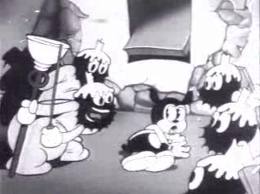The following is purely speculative, ill thought through, vague, and inconclusive, from my still sleepy Saturday morning head that cannot even, at this time, feel bothered to check facts or references. I’ll think of this as a memo to myself to return to this topic at a later moment when I’ve found the time and opportunity to do a bit of reading and to think it through a tad more seriously.
My starting point is, as ever:
When you present yourself in a virtual world such as Second Life, who are you?
with always, back of my mind, the understanding that long-term immersive engagement in Second Life nurtures the emergence a virtual persona that may potentially, if not inevitably, to some degree reflexively engender changes in one’s real life perceptions and understandings. To be blunt about it, Second Life has the potential to transform lives; and it is the recognition of that potential that, for example, has underlain SL-based projects and therapies in such areas as post-traumatic stress disorder, Aspergers, post-deployment soldier support, and social phobia treatment. The question we’ll at some point wish to ask, therefore, is: “When you re-present yourself in Real Life, who are you now, who have you become?
The ‘cognitive transformation’ perspective on the virtual environment triggered in my mind this morning the thought that Second Life may accidentally in this respect have evolved in the hands and minds of its users in such a way that it has become generically akin to other out-of-ordinary-life environments many of which have, effectively by (sometime collaborative and participatory) design, been fashioned with the purpose or, at least, acknowledged possible outcome, of engineering cognitive change. One thinks of, for example, the assumed ritual use of the caves of Lascaux and Altamera, the cult of Demeter and the Eleusinian Mysteries, the rites of passage in traditional and pre-modern societies, the vodun (voodoo) rituals of West Africa, Haïti and Brazil, the self-flagellation of Shia Muslims during the festival of Ashura, the evangelical church meetings in the USA and elsewhere, the euphoria of many a rock festival, the “time-out-from-life” package tour holiday to the Mediterranean, etc (you can, I’m sure, think of as many more examples as I can), the specialness of the activity or event in many instances reinforced by its occurrence in a locale away from one’s normal daily activities–in other words, like SL, a place apart.
Second Life, in short, is for many users an accidental ‘experimentarium’, a transformative laboratory of the mind, a vas philosophorum, a technology serving in the 21st century a purpose not radically different from its historical antecedents. In much the way that, for example, letter-writing, community formation and management, or the dissemination of news, are not new but have found new expression through email, social networking sites, and online newspapers, so too a place apart for reflection and experiment, freed from (though not necessarily free from) the social and material constraints of real life, has found new expression in free-form multi-user virtual environments such as Second Life.
OK, now I confess that that the above is a gross simplification and remind you that I’ve yet to think this thing through seriously. Comments on these informal musings will nonetheless be welcome.



Is this your message, Khoisan? I just had to rewrite it to see if I understand right.
When you present yourself in a virtual world such as Second Life, who are you?
Long term engagement in second life may change one’s understanding of Real Life. The ability of SL to change this understanding has spawned projects such as post-traumatic stress disorder, Aspergers, post-deployment soldier support, and social phobia treatment. The question is “How have your perceptions of RL changed since first entering SL. Who have you become?
This change may have been brought about in a similar way to other out-of-ordinary-life environments which are designed to influence us. Examples such as the assumed ritual use of the caves of Lascaux and Altamera, the cult of Demeter and the Eleusinian Mysteries, the rites of passage in traditional and pre-modern societies, the vodun (voodoo) rituals of West Africa, Haïti and Brazil, the self-flagellation of Shia Muslims during the festival of Ashura, the evangelical church meetings in the USA and elsewhere, the euphoria of many a rock festival, the “time-out-from-life” package tour holiday to the Mediterranean, etc. The message of the event is reinforced by taking place away from normal daily activities – in other words, like SL, a place apart.
Second Life has for many, become a laboratory of the mind for reflection and experiment, freed from the social and material constraint of Real Life, but not necessarily free from the ethics of Real Life.
A reasonable synopsis, Alexi, with very little of my original argument sacrificed.
🙂